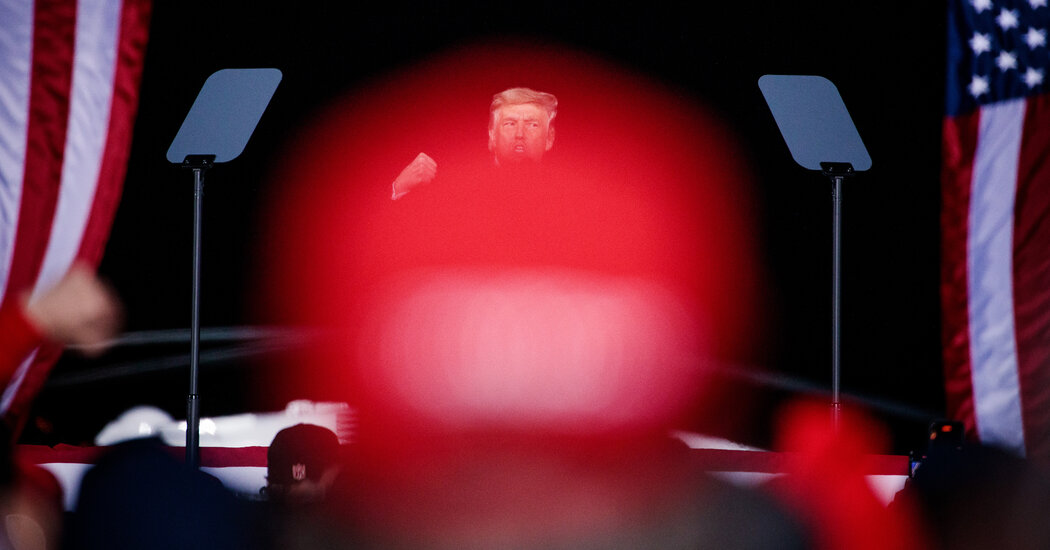Investigating Trump Is Fraught, but Not Doing So Is Worse

There are more than a few commentators and observers who are afraid of what might happen to the United States if the F.B.I. continues its investigation into Donald Trump’s handling of classified documents. They are afraid of violence and civil unrest as the most dedicated Trump supporters take arms in defense of their leader. They are afraid of political instability and civic dissolution, as the Republican Party turns against the rule of law in support of the former president. And they are afraid of what might happen if Trump wins the White House a second time and decides to use his power for revenge.
Rather than confront Trump, they want to leave him alone. As my colleague Michelle Goldberg notes in her latest column, this is foolish. What we already know, she writes, is that “the failure to bring Trump to justice” has been “disastrous.” Indeed, if Trump had been held to account for his corruption and financial wrongdoing as a private citizen in the 1980s and 1990s, we might never have had Trump as a problem in the first place.
In any case, I would like to make a point related to Michelle’s: While the consequences of action might be dire, the consequences of inaction might be even worse.
Last year, I wrote about a time in American history when state and federal authorities allowed powerful elites and their violent supporters to run roughshod over the rule of law. In former Confederate states like Louisiana and Mississippi, vigilantes attacked and harassed Black and white Republican voters while wealthy elites worked to undermine Reconstruction governments, inciting mobs, bankrolling paramilitary groups and even participating in violence themselves. In 1874, a “White League” went as far as to seize control of the Louisiana state house in New Orleans, as well as the city hall and arsenal. They aimed to depose the sitting Republican governor and install his Democratic opponent from the previous election in 1872.
If not for the timely arrival of federal troops, it would have worked. Instead, the White League slinked away, its leaders free to organize another attack. And two years later, they did just that.
As I wrote then, to go slow — or worse, to take no action at all — in the face of lawlessness “will only create a sense of impunity,” and that impunity can lead to something much worse than “chaos and mayhem.” It can lead, as it did in the South for most of a century, to tyranny.
Now Reading
David Daley on the war on the Reconstruction amendments to the Constitution for The Forum.
Caitlin Dickerson on the Trump administration’s policy of child separation for The Atlantic.
Trevor Jackson on crypto for Dissent magazine.
Jennifer Wilson on Alexander Pushkin for The New York Review of Books.
Wanda Bertram on public safety for The Baffler.
Feedback If you’re enjoying what you’re reading, please consider recommending it to your friends. They can sign up here. If you want to share your thoughts on an item in this week’s newsletter or on the newsletter in general, please email me at [email protected]. You can follow me on Twitter (@jbouie), Instagram and TikTok.
Photo of the Week
It’s a nice, pleasant, sunny day here in Charlottesville, so I thought I would mark the occasion with some sunflowers. I took this last year, at a sunflower festival out near Orange, Va.
Now Eating: Spicy Corn Pakoras
I have been eating these for lunch the last few days, and they are delicious. They are supposed to be shallow-fried in about an inch of oil, but you can get away with just using a tablespoon or two of oil per batch and treating them a little like pancakes. The recipe, which comes from New York Times Cooking, says to serve them with a mango-tamarind chutney, but I have been eating them with a cucumber raita to balance the heat with something cool and crisp.
Ingredients
-
¼ cup chickpea flour
-
¾ cup all-purpose flour
-
1 cup fine cornmeal
-
1 ½ teaspoons kosher salt
-
½ teaspoon baking powder
-
½ teaspoon turmeric powder
-
2 ½ cups fresh corn kernels (about 6 ears corn)
-
4 tablespoons ghee, clarified butter or vegetable oil
-
½ teaspoon cumin seeds
-
½ teaspoon fennel seeds
-
½ teaspoon mustard seeds
-
1 teaspoon finely chopped fresh red or green chile, or ¼ teaspoon cayenne
-
½ cup chopped scallions
-
½ cup chopped cilantro, tender stems and leaves
-
1 tablespoon grated ginger
-
Vegetable oil, for frying
-
Lime wedges
Directions
In a mixing bowl, combine chickpea flour, all-purpose flour, cornmeal, salt, baking powder and turmeric.
In a food processor, grind corn kernels to a rough purée. Add purée to flour mixture and stir well to make a stiff batter.
Put ghee in a small pan over medium-high heat. Add cumin, fennel and mustard seeds. When seeds are lightly toasted and begin to pop, pour mixture into the batter. Add chile, scallions, cilantro and ginger, and stir well. (Batter may be prepared several hours in advance.)
Pour vegetable oil into a cast-iron skillet to a depth of 1 inch. Heat on medium-high until oil looks wavy. Using two large soup spoons, carefully slip morsels of batter into the oil, working in batches if necessary. Adjust the heat so pakoras brown gently on one side, about 2 minutes. Turn pakoras and brown on other side, about 2 minutes more. Remove with a slotted spoon or spatula and blot on paper towels. Serve hot with lime wedges and chutney or raita.
